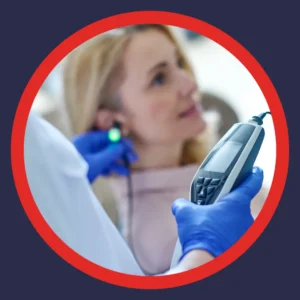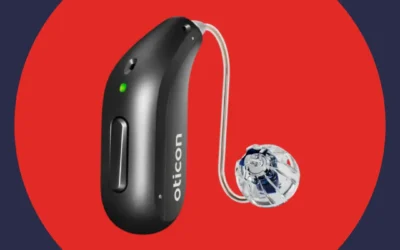Hearing aids can transform your life. But only when they’re fitted correctly. That’s where real ear measurement makes all the difference. If you’ve ever worn hearing aids that felt too loud, too soft, or simply “off,” you’re not alone. Many people are fitted without this critical verification step.
Real ear measurement is the gold standard in hearing aid fitting. It ensures your devices are calibrated specifically for your ears and hearing needs. In this article, we’ll break down what real ear measurement is, how it works, and why you should always request it.
Explore CROS hearing aids.
What Is Real Ear Measurement?
Real ear measurement, often abbreviated REM, is an in-ear verification test. It checks whether your hearing aid is delivering the right amount of sound directly to your eardrum.
Rather than relying on guesswork or generic settings, REM uses a tiny microphone to measure sound inside your ear canal. This shows your hearing care provider how well your hearing aid matches your unique hearing prescription.
According to a systematic review, REM significantly improves speech understanding and patient satisfaction. It also helps ensure you wear your hearing aids more consistently.

Why Isn’t Manufacturer Programming Enough?
When hearing aids leave the factory, they’re set to general default settings. These settings don’t account for your specific hearing loss or the shape of your ear canal.
Your ear canal plays a huge role in how sound is delivered to your eardrum. Two people with identical hearing loss might need completely different settings based on ear canal size and shape.
Without real ear measurement, hearing aids can underperform by 7 to 10 decibels. That difference may mean the world when trying to hear soft voices or conversations in noisy places.
How Does Real Ear Measurement Work?
The real ear measurement process is fast and painless. It usually takes about 10 to 15 minutes. Here’s what to expect:
Step 1: Otoscopy
Your hearing care provider first checks your ears for wax or blockage. This ensures nothing interferes with the test.
Step 2: Probe Tube Placement
A thin microphone tube is gently inserted into your ear. It sits just a few millimeters from your eardrum. Most people say it tickles but doesn’t hurt.
Step 3: Insert Hearing Aids
With the probe in place, your hearing aids are inserted and turned on.
Step 4: Test Sounds Play
Your provider plays various speech sounds or test signals. These may include clips of speech, like a man talking about carrots.
Step 5: Real-Time Measurements
The microphone measures how the hearing aids amplify soft, medium, and loud speech. This confirms whether you’re getting the correct volume at each level.
Step 6: Adjustments
If the aids aren’t hitting the target levels, the provider adjusts them. They may re-test and fine-tune until everything matches your hearing prescription.
Step 7: Your Feedback
Your provider removes the probe and asks how things sound. Your opinion still matters. If something feels too loud or too soft, adjustments can be made.
Real Ear Measurement vs. Live Speech Mapping
Many people confuse real ear measurement with live speech mapping (LSM). While both test how sound behaves in your ear, there are key differences.
What’s the Same?
- Both use a probe microphone in the ear canal.
- Both measure how the hearing aid performs.
- Both help optimize hearing aid settings for your needs.
What’s Different?
REM usually uses artificial speech-like sounds. It involves switching between test software and hearing aid software. This process is very precise but can be time-consuming.
LSM uses real speech or recorded speech clips. Adjustments are made live in real-time. This saves time and allows loved ones to participate in the fitting by speaking into the system.
Each method has strengths. Many providers use both together to give you the most accurate fitting possible.
The Benefits of Real Ear Measurement
When hearing aids are fit using real ear measurement, the results are impressive. Here’s what the research and patient outcomes show:
1. Better Speech Clarity
Real ear measurement helps you hear speech more clearly, especially in quiet environments.
2. Improved Understanding in Noise
REM improves speech intelligibility in noisy settings. That includes restaurants, crowds, and meetings.
3. Personalized Fitting
REM fine-tunes your hearing aids to your ear anatomy. It ensures no under- or over-amplification.
4. Increased Satisfaction
Patients who receive REM report higher satisfaction and fewer returns or adjustments.
5. Reduced Tinnitus Distress
Accurate fittings can reduce the discomfort of tinnitus and improve your quality of life.
6. Greater Hearing Aid Use
People fit with REM are more likely to wear their devices daily. That leads to better long-term outcomes.
Discover how healthy hearing helps with healthy aging.
Why Do So Many Skip It?
Shockingly, only about 30% of U.S. hearing providers use real ear measurement. Why?
Some don’t have the equipment. Others may skip it due to time constraints. Unfortunately, patients often suffer the consequences. Studies show that two-thirds of hearing aid users are fit incorrectly.
That’s why it’s crucial to ask your hearing care provider if they perform real ear measurement. If they don’t, you may want to keep shopping.
Common Misconceptions About REM
Let’s clear up some myths about real ear measurement.
“It’s only for complex hearing loss.”
False. Everyone benefits from REM, even people with mild hearing loss.
“It’s uncomfortable.”
Most patients say the probe feels like a tickle. It’s not painful.
“It takes too long.”
The process usually takes less than 15 minutes per ear.
“My provider says it’s not necessary.”
That may be true for some providers—but not for your ears. You deserve precise fitting.
What Does the Science Say?
A systematic review assessed data from six controlled studies. The review found that REM fittings improved:
- Speech understanding in quiet (SMD: 0.59)
- Self-reported listening ability (SMD: 0.22)
- Speech in noise (SMD: 0.15)
- Patient preference (a difference of 52.2%)
The evidence showed moderate to high quality for most outcomes. While more research is needed on long-term impact, the short-term benefits are clear and measurable.

Why REM Should Be a Best Practice
REM isn’t just a nice-to-have. It should be a standard practice in every hearing aid fitting. Think of it like this:
Would you wear prescription glasses that weren’t adjusted to your exact vision? No? Then why settle for hearing aids set to generic presets?
Learn more about comparing hearing aid centers.
How to Get the Most From Your Hearing Aids
Real ear measurement is one essential piece. But there are other steps to maximize your hearing aid performance.
1. Schedule Follow-Up Appointments
Return to your provider every 6 to 8 months for cleaning, checks, and fine-tuning.
2. Update Your Hearing Test
Hearing can change. Update your hearing exam every 18 to 36 months.
3. Upgrade Outdated Technology
If your hearing aids are over five years old, new models may offer significant improvements.
4. Act Fast on Sudden Changes
If your hearing drops suddenly, call your provider. Fast action can make a difference.
Find out more about the causes of hearing impairment.
Real Ear Measurement Is Worth It
REM isn’t flashy. It’s not something you’ll see advertised in big letters. But it might be the most important part of your fitting process.
Accurate verification with REM ensures that your hearing aids match your hearing loss and your ear canal. Without it, you’re guessing.
And hearing should never be guesswork.

Ready to Hear the Difference?
At American Hearing + Audiology, we use real ear measurement to give every patient a precise, personalized hearing aid fit. Our experienced providers use state-of-the-art verification tools to ensure your hearing aids work for you—right from the start.
If you’re ready to improve your hearing and want to make sure your devices are programmed correctly, Contact American Hearing and schedule an appointment today.
Your hearing is personal. Your hearing aids should be, too.



